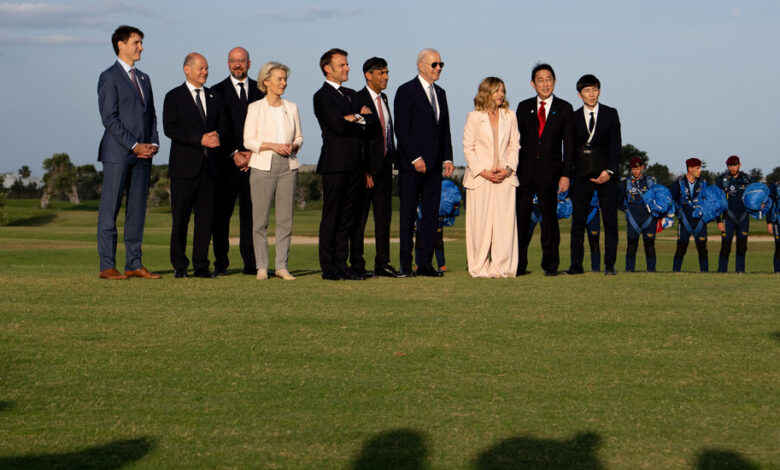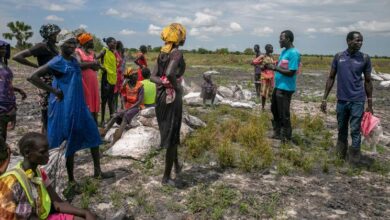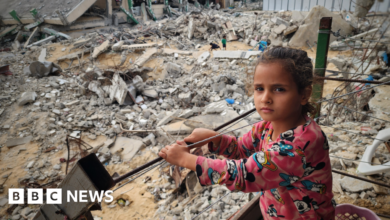Things to know about Ukraine’s $50 billion loan backed by Russian assets

On Thursday, the United States and other major Group of 7 economies agreed on a plan to give Ukraine a $50 billion loan to help the country buy weapons and begin rebuilding damaged infrastructure. . This move comes at a crucial time in the war, when Russia is gaining momentum on the battlefield.
The details haven’t been fully resolved, but here’s what we know.
Where will the money come from?
The upfront money for the loan will come from the United States, the European Union and other G7 countries, although details on how much each unit will contribute are being worked out.
The idea is to use nearly $300 billion worth of Russian assets in the West, frozen after Moscow invaded Ukraine in February 2022, as the basis for the loan. This amount will be repaid over time with profits from those Russian assets, about two-thirds of which are in Europe.
Many of the assets are in bonds that have matured, generating interest, depending on interest rates, of $3 billion to $4 billion a year.
Instead of just providing Ukraine with that annual amount, which is relatively small compared to the needs of the war, the G7 countries agreed on a loan that could be provided to Ukraine later this year.
Ukraine’s current financial and military needs are estimated at about 100 million USD/year.
Which countries will contribute?
G7 countries have agreed at the leadership level to fund the loan.
The Americans have said they will contribute the full amount but want others to participate. A senior European official, who spoke on condition of anonymity to discuss closed financial discussions, said Friday morning that all of these issues remain up for discussion but for now, The European Union is prepared to spend half, about $25 billion to $30 billion, with the rest going to the Americans and others. This money will come from the European Union’s financial support budget.
Leaders of EU countries will have to sign off on any of the bloc’s commitments, the official said.
Since most of the assets are in Europe, the Europeans want to ensure that when the proceeds are spent, European companies receive a fair share, especially European arms manufacturers.
Britain, Canada and Japan, all G7 countries, have also said they are ready to participate.
Ukraine will be the beneficiary of profits from Russian assets and will not be responsible for repaying the loan.
What happens if interest rates fall?
One of the key issues is who is responsible for the loan if interest rates fall or if suddenly there is a peace agreement freeing up Russian assets.
It seems unlikely that these assets will be frozen as the G7 previously agreed that they would be used to finance the post-war reconstruction of Ukraine. Since the amount of money needed to rebuild the country is at least twice the size of the frozen assets and grows as the war continues, it is unlikely that Russia will get those assets back.
Even so, who will guarantee the loan remains vague – liability is expected to be shared between the countries issuing it, according to two European officials close to the negotiations.
What will this money be used for?
Officials said the loan will be transferred to Ukraine in various disbursements later this year and will be for three main purposes: supporting Ukraine militarily, including helping the country establish weapons factories on its territory; to help cover the country’s budget deficit; and help with urgent infrastructure reconstruction.
Disbursement is said to depend partly on Ukraine’s ability to use the money to good effect.
However, officials said how the money will be disbursed and through which agency is still being discussed. They say the World Bank is a possibility. Nigel Gould-Davies, a senior fellow at the International Institute for Strategic Studies who is studying the issue, said another question is whether Ukraine will be able to decide for itself how to use the money. “Or,” as he said, “will it be decided for Ukraine?”
“There are a lot of details that we don’t know,” Mr. Gould-Davies said, noting that he would prefer a more direct foreclosure, which would be simpler. But some countries and central bank governors, including Christine Lagarde, head of the European Central Bank, have rejected that approach for now because it would set a dangerous precedent. .
Mr Gould-Davies said the current plan was “sub-optimal compared to total confiscation”.
“It is more complicated and requires complex financial engineering that seizure would not require,” he added.
However, he admitted: “Given our situation a few days ago, this result was higher than expected.”
Ursula von der Leyen, President of the European Commission, the European Union’s executive body, said the deal was “a very strong message to Putin that Putin cannot outlast us and we I will stand by Ukraine as long as that happens.”
In a nod to Europeans already worried about the costs of war, she added: “It is not European taxpayers who are paying the price for Russia’s losses, it is Russia.”




